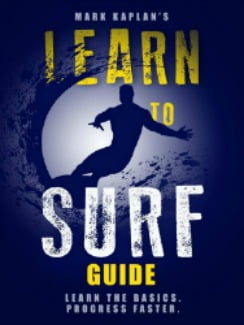Advancing From Beginner Surfer to Intermediate
Advancing from beginner surfer to intermediate requires patience, learning, strengthening, and courage. Surfing is physically demanding, requires focused learning, and practice.
It is important to practice often but out of the water activities can help. Beginners should practice the correct pop up in their living room every day to build smoothness and strength. Cross training with aerobics and strength training will help paddling. Watching video, reading, and other surfers improves techniques.
Catching Waves is a Life Long Practice
Beginner surfers start with soft top boards in foam waves. They learn to judge which wave to ride, timing of catching the wave, when to pop up, and how to ride the surf board to the beach.
If the surfer cannot master each of these steps, they should get instructions on how to improve. Each one is crucial for catching real waves. Foam waves form a long line and the surfer has time. Real waves arc and the surfer has to let the wave roll under them to paddle down the face.
Real waves can be different on reef breaks or sand bar bottoms. Learning the characteristics of each is important. Watching surfers in the line up is one way to learn the timing. Beginner surfers often start catching waves in the corners after they break.
More advanced surfers get close to the apex as it first breaks. The advantages of catching the wave at the apex is it gives the surfer the right of way on the wave. Secondly, the wave is faster at the apex and the drop is steeper. Professionals get more points for catching the wave at the apex.
Learning Surfing Maneuvers
The beginner surfer masters riding straight to the beach without falling off the surf board. Then he learns to ride in the pocket. He begins by catching a real wave and driving until the wave dies. Then he learns to do cut backs so he can return to the power and ride longer.
The beginner surfer on real waves learns the bottom turn to get into the pocket and escape a collapsing wave over the top. The bottom turn is executed by turning the eyes and then head and upper torso in the direction of the carve. As the upper torso turns, there is pressure placed on the toes or heels, whichever is on the side of the carve.
Finally the beginner surfer on real waves learns to accelerate. This is moving the nose of the board up and down the face for speed. It is necessary to stay ahead of the falling lip.
Learn More
For Oceanside Surf Lessons, see the Home Page
See the Post Surf Lessons Begin with Foam Waves
See the Post What You Learn in a 2 Hour Lesson
See the Post How to Progress in Surfing
See My Dry Land and In Water Demo video
See How to Catch a Green/Real Wave video
i have lowered my book and course prices for the lock down.
My New Surfing Course in an E-Book plus Demo Video
Get the 18 Chapter, 7,500 word Course that can prepare you for a lesson or give you the fundamentals if you are going to try it on your own. 10 years of teaching 350 students a year has given me the insights on the most precise measures you must follow for success. This course is what I teach on the dry land and in water instruction. The Course includes a 15 minute video on my dry land and in water demonstration. Only $4.95
Buy the E-book for $2.99. Learn to Surf (Different cover but same book)
Buy the Paperback on Amazon $6.95
Get Learn to Surf Course in 29 minute audio. Great prep for a lesson, reviewing after a lesson, learning on your own, refreshing after not having surfed for a while. See Table of Contents. Only $7.95

80 page Learn to Surf Book
![Surf Instructions Beginner to Advanced: Learn to Ride Waves by [Kaplan, Mark]](https://images-na.ssl-images-amazon.com/images/I/51HswFtoBQL.jpg)
Buy my E-book on Amazon Kindle for $2.99. 80 pages of beginner to advanced instructions to help you before the first lesson to learning expert techniques and tricks.
I also have books on Creating Your Own Happiness on a site called Happiness and Work Life Balance